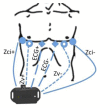Wearable biomedical measurement systems for assessment of mental stress of combatants in real time
- PMID: 24759113
- PMCID: PMC4029694
- DOI: 10.3390/s140407120
Wearable biomedical measurement systems for assessment of mental stress of combatants in real time
Abstract
The Spanish Ministry of Defense, through its Future Combatant program, has sought to develop technology aids with the aim of extending combatants' operational capabilities. Within this framework the ATREC project funded by the "Coincidente" program aims at analyzing diverse biometrics to assess by real time monitoring the stress levels of combatants. This project combines multidisciplinary disciplines and fields, including wearable instrumentation, textile technology, signal processing, pattern recognition and psychological analysis of the obtained information. In this work the ATREC project is described, including the different execution phases, the wearable biomedical measurement systems, the experimental setup, the biomedical signal analysis and speech processing performed. The preliminary results obtained from the data analysis collected during the first phase of the project are presented, indicating the good classification performance exhibited when using features obtained from electrocardiographic recordings and electrical bioimpedance measurements from the thorax. These results suggest that cardiac and respiration activity offer better biomarkers for assessment of stress than speech, galvanic skin response or skin temperature when recorded with wearable biomedical measurement systems.
Figures












References
-
- Chan M., Esteve D., Fourniols J.Y., Escriba C., Campo E. Smart wearable systems: Current status and future challenges. Artif. Intell. Med. 2012;56:137–156. - PubMed
-
- Lanata A., Scilingo E.P., de Rossi D. A multimodal transducer for cardiopulmonary activity monitoring in emergency. IEEE Trans. Inf. Technol. Biomed. 2010;14:817–825. - PubMed
-
- Di Rienzo M., Rizzo F., Meriggi P., Castiglioni P., Mazzoleni P., Ferrarin M., Ferratini M. MagIC: A textile system for vital signs monitoring. Advancement in design and embedded intelligence for daily life applications. Proceedings of 29th Annual International Conference of the IEEE Engineering in Medicine and Biology Society; Lyon, France. 22–26 August 2007; pp. 3958–3961. - PubMed
-
- Reiter H., Muehlsteff J., Sipila A. Medical application and clinical validation for reliable and trustworthy physiological monitoring using functional textiles: Experience from the HeartCycle and MyHeart project. Proceedings of IEEE-EMBC; Boston, US. 30 August–3 September, 2011; pp. 3270–3273. - PubMed
-
- Polar Electro Oy Polar H6 Hear Rate Sensor. [(accessed on 10 March 2014)]. Available online: http://www.polarusa.com/us-en/products/accessories/H6.
Publication types
MeSH terms
LinkOut - more resources
Full Text Sources
Other Literature Sources
Medical

